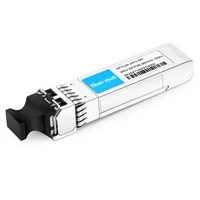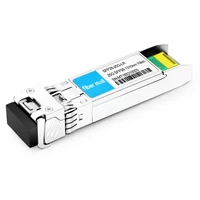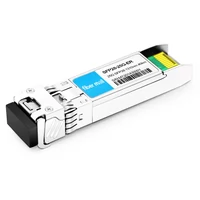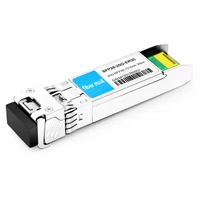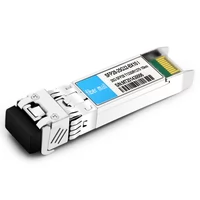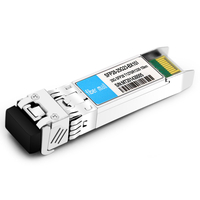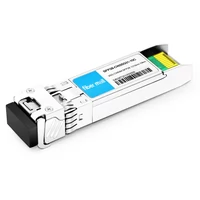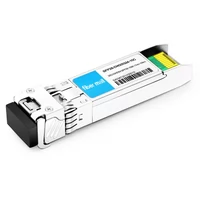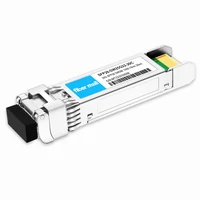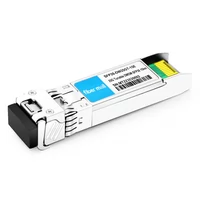As we know, energy-saving and cost are two important factors to consider when deploying networks in data centers. 40G optical transceivers and 100G optical transceivers are expensive and consume a lot of power, while 10G optical transceivers cannot meet the network demand, so 25G SFP28 optical transceivers are born under such circumstances, which just makes up for the shortcomings of the first three, greatly improves the port density, reduces the network deployment cost, and the power consumption is relatively low.
The 25G optical module is an optical module with a transmission rate of 25Gbps, mainly used in 25G Ethernet and 100G (4x25Gbps) Ethernet. The package is SFP28, and its function is for interconnecting servers and switches in data centers. 25G optical modules can provide the most energy-efficient way to meet the growing needs of data center networks.
Table of Contents
ToggleTypes of 25G Optical Transceivers
25G SFP28 SR
The SFP28 SR transceiver is a single-channel, pluggable fiber SFP28 optical module for 25 Gigabit Ethernet and Infiniband EDR. It is a high-performance short-range data communications module that transmits 70 meters over OM3 multimode fiber and 10 meters over OM4 multimode fiber. The module is designed to use a multimode fiber system with a wavelength of 850nm and an electrical interface using 20 pieces of contact edge-type connectors. the SFP 25G SR S optical transceiver complies with multiple standards and specifications such as IEEE 802.3, SFF-8472, SFF-8402, SFF-8432, and SFF-8431 with a center wavelength of 850nm.
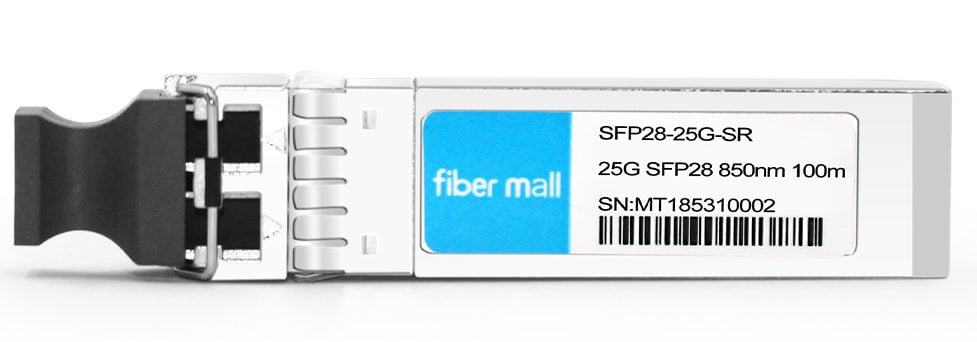
Because the transmitter inside the SFP 25G SR optical module is a vertical-cavity surface-emitting laser (VCSEL), it needs to be used with OM3/OM4 multimode fiber with a fiber diameter of 50/125µm, which is a short-range transmission optical module. In addition, SFP28 SR optical module has digital optical monitoring (DOM) function, which can help network management to monitor all aspects of optical module information in real-time, and is mainly used in 25G Ethernet switches, routers, network interface cards, and storage network equipment.
25G SFP28 LR
The SFP28 LR transceiver is a single-channel, pluggable fiber SFP28 optical module for 25 Gigabit Ethernet and Infiniband EDR. Moreover, the 25G LR module supports communication and interconnection applications with a transmission distance of up to 10km. The optical interface of SFP28 LR adopts a duplex LC optical interface. The SFP 25G LR optical module complies with multiple standards and specifications such as IEEE 802.3, SFF-8472, SFF-8402, SFF-8432, and SFF-8431. Its central wavelength is 1310nm. It is usually used with single-mode optical fiber, and the transmission distance can reach 10km. It is suitable for long-distance data transmission. The SFP 25G LR optical module adopts the DFB laser.
25G SFP28 ER
The 25G SFP28 ER optical module with a center wavelength of 1310nm, duplex LC interface, single-mode, supports a commercial-grade operating temperature range (0°C~70°C). It’s generally used with single-mode patch cable OS2. It is widely used in the data center 25G Ethernet and 5G forward CPRI/eCPRI networks with the longest transmission distance of up to 40 km.
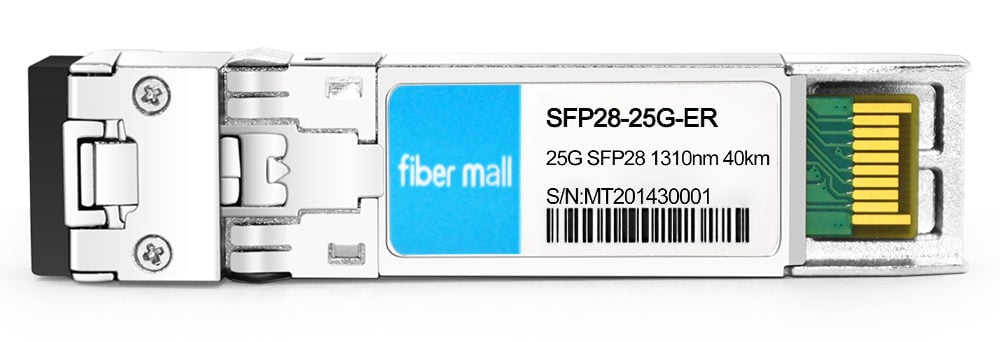
25G CPRI SFP28 ER Lite
The 25G SFP28 ER Lite (ER30) optical module with a center wavelength of 1310nm, duplex LC interface, single-mode, supports a commercial-grade operating temperature range (0°C~70°C). The SFP28 ER30 optical module can transmit up to 30km (without FEC on) or 40km (with FEC on) through single-mode fiber.
25G CPRI SFP28 BIDI
SFP28 BIDI transceiver with a center wavelength of 1270nm-Tx, 1330nm-Rx, simplex LC interface, single-mode, supports industrial-grade operating temperature range (-45°C to 85°C). Generally used with single-mode patch cable OS2. It is widely used in the data center 25G Ethernet and 5G forward CPRI/eCPRI networks, with the longest transmission distance of up to 40 km.
25G SFP28 CWDM
SFP28 CWDM transceiver with the wavelengths of 1470nm-1570nm (interval 20nm), duplex LC interface, single-mode, supports industrial-grade operating temperature range (-20°C~85°C). It is generally used with single-mode patch cable OS2. It is widely used in the data center 25G Ethernet and 5G forward CPRI/eCPRI networks with the longest transmission distance of up to 10 km.
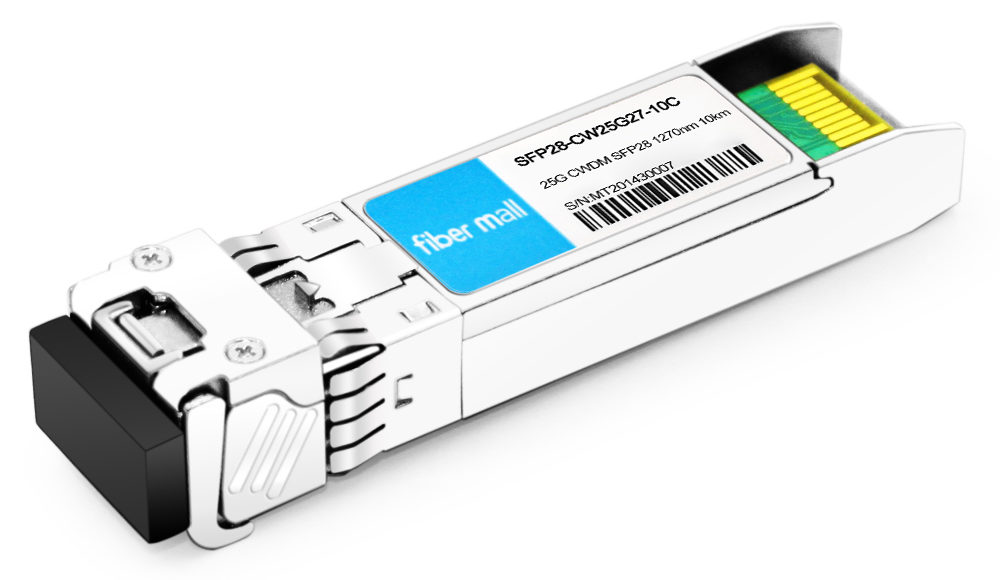
25G SFP28 DWDM
Its fixed wavelength is C18-C61 (interval 100GHz), duplex LC interface, single-mode, supports industrial-grade operating temperature range (-20°C to 85°C). It is generally used with single-mode patch cable OS2. It is widely used in the data center 25G Ethernet and 5G forward CPRI/eCPRI networks, with the longest transmission distance reaching 10 km.
Of course, each brand manufacturer’s optical module models are different and not necessarily compatible with your switch. For example, HPE optical transceivers have a very complex classification and their own independent technical system. HPE’s 25G optical modules are mainly Comware-based. So, for more efficiency and also cost savings, it is actually better to choose a third-party manufacturer’s optical module than OEM.
SFP28 vs. QSFP vs. QSFP28 vs. Other Transceivers
25G SFP28 vs 100G QSFP28
The 25G SFP28 optical module is mainly used for the interconnection of data center servers and switches. It is a new Ethernet standard with many advantages. It was proposed by IEEE 802.3 working group in July 2014 and revised in June 2016. The biggest advantage of 25G Ethernet technology for the data center is that it can maximize the bandwidth and port density, and it can also use 4x25Gb/s technology to realize 100GB of data transmission.
The main types of 100G optical modules are CFP/CFP2/CFP4/QSFP28, of which the QSFP28 (Quad Small Form Factor Pluggable) is the mainstream 100G optical module in the market today. Because of its advantages of small size, high port density, and low power consumption, it is loved by the majority of manufacturers. The transmission wavelength of the 100G QSFP28 optical module is 1310nm, and its transmission distance can reach 2km with a single-mode 12 core MTP (MPO) connector. The size of the QSFP28 transceiver is smaller than the other 100G modules.
25G SFP28 vs 40G QSFP+
The 40G optical modules are more commonly known as CFP, QSFP, and QSFP+ optical modules. The 40G QSFP+ optical modules are products that have evolved from QSFP and are designed for high-density applications with higher port density and lower overall system costs than traditional SFP+ optical modules. The 40G QSFP+ optical modules are compliant with SCSI, 40G Ethernet, 20G/40G Infiniband, and many other standards. It has four data transmission channels, each with a transmission rate of about 10Gbps, and four channels can achieve a transmission rate of 40Gbps at the same time. The 25G SFP28 has the advantage of lower power consumption and lower cost compared to the 40G QSFP+, so the 25G SFP28 optical modules actually are more popular in the market today.
| Feature | 10G SFP+ | 25G SFP28 | 40G QSFP+ | 100G QSFP28 |
| Data Rate | 10 Gbps | 25 Gbps | 40 Gbps | 100 Gbps |
| Form Factor | SFP+ | SFP28 | QSFP+ | QSFP28 |
| Max Distance | Up to 80 km | Up to 80 km | Up to 40 km | Up to 80 km |
| Power Consumption | ~1 W | ~1–3.5 W | ~3.5 W | ~4–8 W |
| Port Density | High | High | Medium | Medium |
| Typical Use Case | Legacy Enterprise | Data Centers, 5G | Data Centers | Hyperscale Networks |
Key Differences:
SFP28 vs. SFP+: SFP28 delivers 2.5x the speed of SFP+ in the same form factor, making it ideal for upgrading 10G networks without major hardware changes.
SFP28 vs. QSFP28: QSFP28 supports 100G but consumes more power and offers lower port density than SFP28, which excels in 25G applications.
SFP28 vs. QSFP+: QSFP+ supports 40G but is less scalable for 100G upgrades compared to SFP28, which aligns better with 25G-to-100G roadmaps.
Benefits of 25G SFP28 Transceivers
25G SFP28 transceivers are increasingly popular due to their unique advantages:
- Cost-Effectiveness: SFP28 modules provide higher bandwidth than 10G SFP+ at a lower cost per gigabit compared to 40G or 100G solutions.
- Low Power Consumption: Typically consuming less than 1–3.5 watts per port, SFP28 transceivers reduce energy costs in high-density deployments.
- High Port Density: The compact SFP28 form factor maximizes switch port usage, optimizing rack space in data centers.
- Scalability: Supports a seamless transition from 10G to 100G networks, ensuring future-proof infrastructure.
- Backward Compatibility: Compatible with SFP+ ports, allowing gradual upgrades without replacing existing hardware.
- Versatility: Supports a wide range of distances and fiber types, from short-range MMF to long-haul DWDM applications.
Applications of 25G SFP28 Transceivers
25G SFP28 transceivers are deployed across various high-speed networking environments:
- Data Centers: SFP28-SR modules connect servers to ToR switches over short distances, while SFP28-LR modules link ToR switches to aggregation switches up to 10 km away.
- 5G Fronthaul Networks: SFP28-BiDi and CWDM modules support the high-bandwidth, low-latency requirements of 5G base stations.
- Enterprise Networks: SFP28-LR and ER modules connect geographically dispersed offices or campuses, ensuring reliable long-distance connectivity.
- Metro and Telecom Networks: SFP28-CWDM and DWDM modules enable high-capacity, long-haul data transmission for service providers.
Frequently Asked Questions (FAQs)
Q: Are 25G SFP28 transceivers compatible with SFP+ ports?
A: Yes, most SFP28 modules are backward compatible with SFP+ ports but operate at 10G speeds.
Q: What is the maximum distance supported by 25G SFP28 transceivers?
A: DWDM SFP28 modules can reach up to 80 km, while SR modules support up to 100 meters.
Q: Can 25G SFP28 transceivers be used in 5G networks?
A: Yes, SFP28-BiDi and CWDM modules are widely used in 5G fronthaul networks for high-bandwidth connectivity.
Q: What standards govern 25G SFP28 transceivers?
A: They comply with IEEE 802.3by (25GBASE Ethernet) and SFF-8431 specifications.
Q: How do SFP28 transceivers support scalability?
A: SFP28 modules enable a smooth transition from 10G to 100G networks, supporting higher bandwidth without requiring a complete infrastructure overhaul.
Related Products:
-
 Cisco SFP-25G-SR-S Compatible 25G SFP28 SR 850nm 100m LC MMF DDM Transceiver Module
$25.00
Cisco SFP-25G-SR-S Compatible 25G SFP28 SR 850nm 100m LC MMF DDM Transceiver Module
$25.00
-
 SFP28-25G-LR 25G SFP28 LR 1310nm 10km LC SMF DDM Transceiver Module
$45.00
SFP28-25G-LR 25G SFP28 LR 1310nm 10km LC SMF DDM Transceiver Module
$45.00
-
 Arista Networks SFP-25G-ER40 Compatible 25G SFP28 ER 1310nm 40km LC SMF DDM Transceiver Module
$125.00
Arista Networks SFP-25G-ER40 Compatible 25G SFP28 ER 1310nm 40km LC SMF DDM Transceiver Module
$125.00
-
 Brocade 25G-SFP28-ER-Lite Compatible 25G SFP28 ER Lite 1310nm 30km LC SMF DDM Transceiver Module
$165.00
Brocade 25G-SFP28-ER-Lite Compatible 25G SFP28 ER Lite 1310nm 30km LC SMF DDM Transceiver Module
$165.00
-
 H3C SFP-25G-LX-SM1330-BIDI Compatible 25G BX BIDI SFP28 TX1330nm/RX1270nm 10km LC SMF DDM Industrial Transceiver Module
$50.00
H3C SFP-25G-LX-SM1330-BIDI Compatible 25G BX BIDI SFP28 TX1330nm/RX1270nm 10km LC SMF DDM Industrial Transceiver Module
$50.00
-
 Juniper JNP-SFP-25G-BX23I Compatible 25G BX BIDI SFP28 TX1270nm/RX1330nm 10km LC SMF DDM Industrial Transceiver Module
$50.00
Juniper JNP-SFP-25G-BX23I Compatible 25G BX BIDI SFP28 TX1270nm/RX1330nm 10km LC SMF DDM Industrial Transceiver Module
$50.00
-
 Huawei CWDM-SFP25G-1310-10 Compatible 25G CWDM SFP28 1310nm 10km LC SMF DDM Transceiver Module
$50.00
Huawei CWDM-SFP25G-1310-10 Compatible 25G CWDM SFP28 1310nm 10km LC SMF DDM Transceiver Module
$50.00
-
 Cisco DWDM-SFP25G-58.17 Compatible 25G DWDM SFP28 C24 100GHz 1558.17nm 10km LC SMF DDM Transceiver Module
$265.00
Cisco DWDM-SFP25G-58.17 Compatible 25G DWDM SFP28 C24 100GHz 1558.17nm 10km LC SMF DDM Transceiver Module
$265.00
-
 SFP28-DW25G22-20C 25G SFP28 DWDM C22 100GHz 20KM 1559.79nm LC SMF DDM Transceiver Module
$600.00
SFP28-DW25G22-20C 25G SFP28 DWDM C22 100GHz 20KM 1559.79nm LC SMF DDM Transceiver Module
$600.00
-
 SFP28-DW25GT-15E 25G Tunable DWDM SFP28 C-band 48 channels 15km Optical Transceiver Module
$550.00
SFP28-DW25GT-15E 25G Tunable DWDM SFP28 C-band 48 channels 15km Optical Transceiver Module
$550.00

